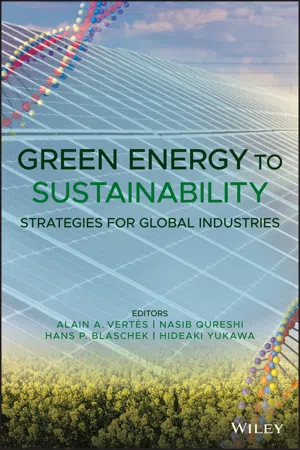
Green Energy to Sustainability: Strategies for Global Industries
- English
- ePUB (mobile friendly)
- Available on iOS & Android
Green Energy to Sustainability: Strategies for Global Industries
About This Book
Reviews the latest advances in biofuel manufacturing technologies and discusses the deployment of other renewable energy for transportation
Aimed at providing an interface useful to business and scientific managers, this book focuses on the key challenges that still impede the realization of the billion-ton renewable fuels vision. It places great emphasis on a global view of the topic, reviewing deployment and green energy technology in different countries across Africa, Asia, South America, the EU, and the USA. It also integrates scientific, technological, and business development perspectives to highlight the key developments that are necessary for the global replacement of fossil fuels with green energy solutions.
Green Energy to Sustainability: Strategies for Global Industries examines the most recent developments in biofuel manufacturing technologies in light of business, financial, value chain, and supply chain concerns. It also covers the use of other renewable energy sources like solar energy for transportation and proposes a view of the challenges over the next two to five decades, and how these will deeply modify the industrial world in the third millennium. The coming of age of electric vehicles is also looked at, as is the impact of their deployment on the biomass to biofuels value chain.
- Offers extensive updates on the field of green energy for global industries
- Covers the structure of the energy business; chemicals and diesel from biomass; ethanol and butanol; hydrogen and methane; and more
- Provides an expanded focus on the next generation of energy technologies
- Reviews the latest advances in biofuel manufacturing technologies
- Integrates scientific, technological and business perspectives
- Highlights important developments needed for replacing fossil fuels with green energy
Green Energy to Sustainability: Strategies for Global Industries will appeal to academic researchers working on the production of fuels from renewable feedstocks and those working in green and sustainable chemistry, and chemical/process engineering. It is also an excellent textbook for courses in bioprocessing technology, renewable resources, green energy, and sustainable chemistry.
Frequently asked questions
Part I
Structure of the Energy Business
1
Economic Growth and the Global Energy Demand
- Historical Context and Relationship Between Energy and Development
- Conceptual Framework for Pathways of Energy Use
- World Population Trends and Prospects
- Gross Domestic Product (GDP) and Economic Growth
- Global Energy Development
- Global Emissions of Greenhouse Gases
- Linkages Between Kaya Factors
- Development of Energy Investment
- Conditions for Energy Transition and Decarbonization
- Perspectives
- Acknowledgments
- References
1.1 Historical Context and Relationship Between Energy and Development
- In the solar energy system of hunters and gatherers, people derive as much energy from their ecological niches as these can deliver sustainably, keeping the material cycles closed.
- The sun was also the only source of energy in the modelled energy system of agrarian societies after the so‐called ‘Neolithic revolution’ 10 000 years ago, when the energy flow was used in a m...
Table of contents
- Cover
- Table of Contents
- About the Editors
- List of Contributors
- Foreword
- Preface
- Part I: Structure of the Energy Business
- Part II: Chemicals and Transportation Fuels from Biomass
- Part III: Hydrogen and Methane
- Part IV: Perspectives
- Index
- End User License Agreement